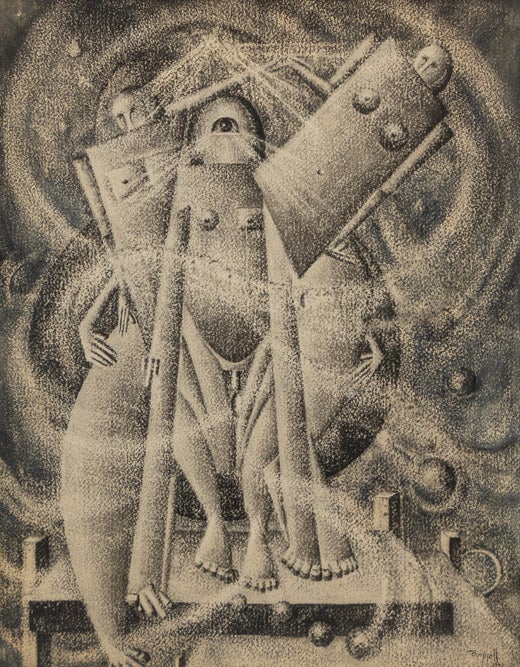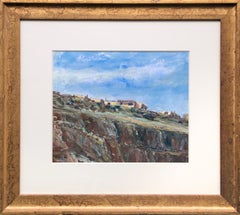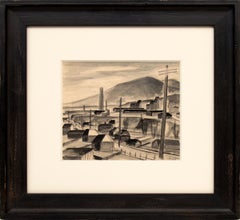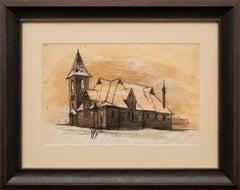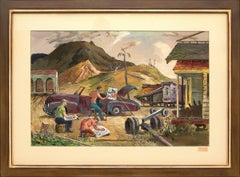Video Loading
Want more images or videos?
Request additional images or videos from the seller
1 of 16
Charles Ragland BunnellCripple Creek Victor Mine Colorado, 1940 Watercolor Mountain Landscape Art1940
1940
$3,250List Price
About the Item
- Creator:Charles Ragland Bunnell (1897-1968, American)
- Creation Year:1940
- Dimensions:Height: 10.25 in (26.04 cm)Width: 11.5 in (29.21 cm)Depth: 1.5 in (3.81 cm)
- Medium:
- Movement & Style:
- Period:
- Framing:Frame IncludedFraming Options Available
- Condition:
- Gallery Location:Denver, CO
- Reference Number:Seller: 258241stDibs: LU27310341622
Charles Ragland Bunnell
Charles Bunnell developed a love for art at a very young age. As a child in Kansas City, Missouri, he spent much of his time drawing. When he was unable to find paper he drew on walls and in the margins of textbooks for which he was often fined. Around 1915, Bunnell moved with his family to Colorado Springs, Colorado. He served in World War I and later used his GI Training to study at the Broadmoor Art Academy (later renamed the Colorado Springs Fine Arts Center) during 1922 and 1923. In 1922, he married fellow student, Laura Palmer. He studied with Ernest Lawson in 1927-1928 and, in the winter of 1928-1929, he served as Lawson’s assistant. In the late 1920’s, the Bunnell’s settled just west of Colorado Springs and 1928, they welcomed the first of their three children. Their one-acre homesite, which they referred to as “Old Home Place”, was situated between two sets of railroad tracks at the foot of Pike’s Peak. Charlie converted an old railroad boxcar into his studio, where he later gave lessons. Beginning in 1931, Bunnell spent a year and a half studying under Boardman Robinson. The two men clashed constantly due to a generation gap and markedly different philosophies. Robinson encouraged his students not to stray from realism and though Bunnell mastered Robinson’s preferred style of American Scene painting, he regularly irritated his professor with his abstract sketches. Bunnell taught at the Kansas City Art Institute during the summers of 1929, 1930, 1940, and 1941. Between 1934 and 1941, he painted and taught under federal projects which included assisting Frank Mechau on murals for the Colorado Springs Post Office. However, he did not take to mural making and, after criticism from Boardman Robinson about his use of “heavy daubs which have no place in mural work,” he abandoned mural-making altogether. By the late 1930’s, Bunnell’s work departed from the American Scene/Modernist style he was trained in towards abstraction. This is marked by his “Black and Blue” series, consisting of 83 abstracted ink and watercolors. Affected by the Second World War and the loss of his 10-year old son, Bunnell’s work of the early 1940’s took on a Transcendental and Surrealist tone. The works from this period are moody and readily reflect the political and personal turmoil experienced by the artist. In the late 1940’s, Bunnell began experimenting with Abstract Expressionism. He alone is credited with introducing Colorado Springs to the new style as it was excluded from the Fine Art Center’s curriculum by Boardman Robinson. Bunnell excelled in Abstract Expressionism and continued to evolve in the style through the 1950’s continuing to his death in 1968. He was recently recognized as a premier American Abstract Expressionist by his inclusion in the book American Abstract Expressionism of the 1950’s: An Illustrated Survey. © David Cook Galleries, LLC
About the Seller
5.0
Gold Seller
Premium sellers maintaining a 4.3+ rating and 24-hour response times
Established in 1979
1stDibs seller since 2013
295 sales on 1stDibs
Typical response time: 4 hours
Authenticity Guarantee
In the unlikely event there’s an issue with an item’s authenticity, contact us within 1 year for a full refund. DetailsMoney-Back Guarantee
If your item is not as described, is damaged in transit, or does not arrive, contact us within 7 days for a full refund. Details24-Hour Cancellation
You have a 24-hour grace period in which to reconsider your purchase, with no questions asked.Vetted Professional Sellers
Our world-class sellers must adhere to strict standards for service and quality, maintaining the integrity of our listings.Price-Match Guarantee
If you find that a seller listed the same item for a lower price elsewhere, we’ll match it.Trusted Global Delivery
Our best-in-class carrier network provides specialized shipping options worldwide, including custom delivery.You May Also Like
1950s "Figure in Shadow" Figurative Gouache Painting America Modernist
By Donald Stacy
Located in Arp, TX
Donald Stacy
"Figure in Shadow"
c.1950s
Gouache paint on paper
24" x 18" unframed
Unsigned
Came from artist's estate
Donald Stacy (1925-2011) New Jersey
Studied: Newark School of Fine Art
The Art Students League
Pratt Graphic Arts Center
University of Paris 1953-54
University of Aix-en-Provence 1954-55
Faculty: Art Department of the New School
Museum of Modern Art
School of Visual Arts
Stacy Studio Workshop
Exhibitions: Grand Central Moderns
George Wittenborn
The New School
Print Exhibitions, Chicago
University of Oklahoma
Honolulu Museum
Monclair Museum
Wisconsin State College
Louisiana Art...
Category
Mid-20th Century American Modern Figurative Paintings
Materials
Paper, Gouache
Hillside and Stream, early 20th century modernist Cleveland School painting
Located in Beachwood, OH
Clara Deike (American, 1881-1964)
Hillside and Stream, 1916
Gouache on paper
Signed and dated lower right
22 x 18 inches
25.5 x 21.5 inches, framed
A graduate of the Cleveland Schoo...
Category
1910s American Modern Figurative Paintings
Materials
Gouache
'Any Day in America', Social Realist, Beat Generation, Allen Ginsberg
By Ron Croci
Located in Santa Cruz, CA
'Any Day in America' by Ron Croci.
Social Realist, Beat Generation, Allen Ginsberg
-----
Signed lower right, "Croci" for Ron Croci (American, born 1945), and painted circa 1970.
A ...
Category
1970s American Modern Figurative Paintings
Materials
Watercolor, Handmade Paper
$5,500
H 22.5 in W 30.5 in
Simka Simkhovitch WPA Artist Oil Painting Gouache American Modernist Powerline
By Simka Simkhovitch
Located in Surfside, FL
Simka Simkhovitch (Russian/American 1893 - 1949)
This came with a small grouping from the artist's family, some were hand signed some were not.
These were studies for larger paintin...
Category
1930s American Modern Landscape Paintings
Materials
Oil, Gouache, Board
"The Glorious Flight - Across the Channel with Louis Bleriot" - Children's Book
By Alice and Martin Provensen
Located in Miami, FL
Study for "The Glorious Flight - Across the Channel with Louis Bleriot"; 1983; Gouache on Illustration Board; 14.5" x 13.75"; Signed Lower Right; Unframed.
From Wikipedia, the free encyclopedia
Alice Rose[1] Provensen (née Twitchell; August 14, 1918[2] – April 23, 2018[3]) and Martin Provensen...
Category
1980s American Modern Figurative Paintings
Materials
Gouache, Board
$15,000
H 14.5 in W 13.75 in D 1 in
Happy California Prune Farmers - Female Illustrator - Mid Century
Located in Miami, FL
Commercial illustration depicting happy California framers for California Prunes. The work is rendered in a charming and highly stylized manner. Unfr...
Category
1950s American Modern Figurative Paintings
Materials
Gouache
$6,000
H 13.5 in W 16.5 in D 1 in
Coronation
By Ben Norris
Located in Boston, MA
Signed and dated top right: “Norris (c) 1982”. With label verso: “Ben Norris, 1982 / Coronation / watercolor, 52 x 31 1/4 inches”.
As a teacher, academic, and artist, Ben Norris had...
Category
20th Century American Modern Figurative Paintings
Materials
Watercolor
Society of Six Street Scene - Figurative Abstract
By Bernard Von Eichman
Located in Soquel, CA
Stunning New York City urban modernist watercolor titled "Summer Afternoon Stroll" by Society of Six artist Bernard Von Eichman (American, 1899-1990), 1...
Category
1930s American Modern Landscape Paintings
Materials
Archival Paper, Watercolor
$7,595
H 28 in W 22 in D 0.25 in
Geese
Located in Palm Desert, CA
A painting by Gregory Sumida. “Geese” is a landscape painting, watercolor on paper in an earth-tone palette by American artist Gregory Sumida. The artwork is signed in the lower left...
Category
Late 20th Century American Modern Figurative Paintings
Materials
Watercolor
"Union Square" NYC American Scene Social Realism Modernism WPA Mid-20th Century
By Agnes Hart
Located in New York, NY
"Union Square" NYC American Scene Social Realism Modernism WPA Mid-20th Century
Agnes Hart (American, 1912-1979)
"Union Square, New York City"
Sight: 14 1/2 x 21 1/2 inches
Gouache...
Category
1940s American Modern Landscape Paintings
Materials
Gouache, Board
More From This Seller
View All1970s Acoma Pueblo, New Mexico Southwest Landscape Gouache Painting, Signed Art
Located in Denver, CO
This stunning gouache painting by Wolfgang Pogzeba (1936-1982) captures the beauty of Acoma Pueblo, New Mexico, depicting a dramatic cliffside landsca...
Category
1970s American Modern Landscape Paintings
Materials
Gouache
1940s WPA-Era Abstract Watercolor of Golden Cycle Mill by Charles Ragland Bunnel
By Charles Ragland Bunnell
Located in Denver, CO
This original 1940s grayscale watercolor by Charles Ragland Bunnell captures a semi-abstracted view of the Golden Cycle Mill in Colorado Springs, Colorado. Rendered in subtle blacks and grays, this striking WPA-era landscape melds industrial subject matter with a modernist aesthetic. The piece exemplifies mid-20th-century American regionalism, blending expressive abstraction with historical significance.
The painting measures 8 1/8 x 9 5/8 inches (sight size) and is showcased in a custom black frame measuring 18 x 19 ½ x 1 ⅜ inches, making it an elegant addition to any collection of American art or industrial landscapes.
The Golden Cycle Mining and Reduction Company was a vital part of Colorado’s early 20th-century mining boom, located in what is now Old Colorado City. Bunnell’s work documents this industrial heritage through a modernist lens, offering a unique narrative of regional development.
About the Artist:
Charles Ragland Bunnell (1897–1968) was a key figure in Colorado’s art scene and a pioneer of American Modernism and abstraction. Trained at Broadmoor Art Academy, he combined American Scene painting with abstract forms. Bunnell contributed to New Deal art...
Category
1940s American Modern Landscape Paintings
Materials
Watercolor
Church in Leadville, Colorado, 1930s Framed Landscape Watercolor & Ink Painting
By Jenne Magafan
Located in Denver, CO
This rare, original WPA-era painting, Church in Leadville (1938), was created by renowned Colorado and Woodstock modernist artist Jenne Magafan (1916-1952). The watercolor and ink wo...
Category
1930s American Modern Landscape Paintings
Materials
Archival Ink, Watercolor
Artists Sketching, California, 1940s Large Modernist Gouache Painting, Landscape
By Frederick Shane
Located in Denver, CO
This original 1940s American Modernist gouache painting, "Artists Sketching (California)," captures a dynamic scene of three artists at work against a majestic mountain backdrop. With expressive brushwork and a rich color palette, the piece embodies Frederick E. Shane’s signature blend of realism and modernist abstraction. Signed, titled, and dated by the artist in the lower margin, this remarkable artwork reflects the era’s Regionalist influence and the artist’s keen eye for capturing creative moments in the natural landscape.
The painting is professionally housed in a custom archival frame, ensuring long-term preservation. Frame dimensions: 25.5 x 37.5 x 1.5 inches. Image size: 20.25 x 29.75 inches.
Provenance: Estate of the Artist, Frederick Shane
About the Artist: Frederick E. Shane (1906-1992)
A celebrated Missouri Regionalist painter and printmaker, Frederick E. Shane was known for his compelling genre scenes, landscapes, seascapes, and portraits in a variety of media, including oil, watercolor, gouache, tempera, and lithography. While fundamentally a realist, Shane often incorporated elements of abstraction, expressionism, and surrealism, adding depth and emotion to his compositions.
During the summers of 1925-26, Shane studied under Randall Davey at the Broadmoor Academy in Colorado Springs, an institution founded in 1919 by philanthropists Spencer and Julie Penrose. Shane remained closely connected to the Colorado Springs Fine Arts Center, the Academy’s successor, throughout the 1940s and early 1950s, participating in Artists West of the Mississippi exhibitions and forming lasting friendships with key figures like Boardman Robinson and Adolph Dehn...
Category
1940s American Modern Landscape Paintings
Materials
Gouache
Paul K. Smith Vintage 1930s New Mexico Adobe Church, Denver Modernist Oil
By Paul Kauvar Smith
Located in Denver, CO
This evocative vintage oil painting from the 1930s–1940s by Denver modernist Paul K. Smith beautifully depicts a classic adobe church in New Mexico, likely insp...
Category
1940s American Modern Landscape Paintings
Materials
Oil
$2,760 Sale Price
20% Off
East Santa Cruz Landscape: Yellow Farmhouse with Storm Clouds Oil Painting
By Jon Blanchette
Located in Denver, CO
East Santa Cruz (California) is a striking original oil painting on canvas board by noted California artist Jon Blanchette (1908–1987). This evocative landscape features a bright yellow farmhouse set against a backdrop of dramatic dark gray storm clouds, capturing the natural beauty and emotional contrast of the California coast. Blanchette’s expert use of light and color creates a compelling sense of both tranquility and approaching tension.
Painted in the mid-20th century, this work reflects Blanchette’s signature romantic realism and deep connection to the California landscape. The painting is presented in a custom frame using archival materials. Framed dimensions: 21 ¾ x 25 ¾ x 1 ½ inches, image size: 16 x 20 inches
About the Artist:
Born in England, Blanchette studied at the Pittsburgh Art...
Category
1950s American Modern Figurative Paintings
Materials
Oil
Recently Viewed
View AllMore Ways To Browse
Beach Modern Painting
Modern Tree Painting
Painting Boats On A Lake
19th Century Maritime Oil Paintings
Moonlight Painting
Paintings With Houses
Blue Waves Painting
Oil On Canvas Paintings By Walter Landscape
Rare Art Paintings
Wildflower Paintings
Big Sur
View Of Venice
Farmer Painting
Italian Street
Mid Century Painting Signed Bernard
Antique Venice Painting
Antwerp Art
Findlay Gallery
